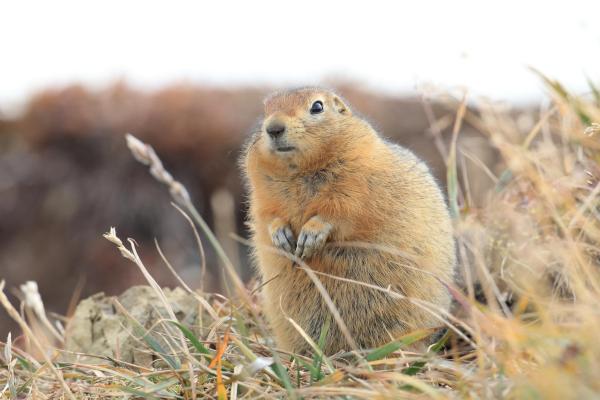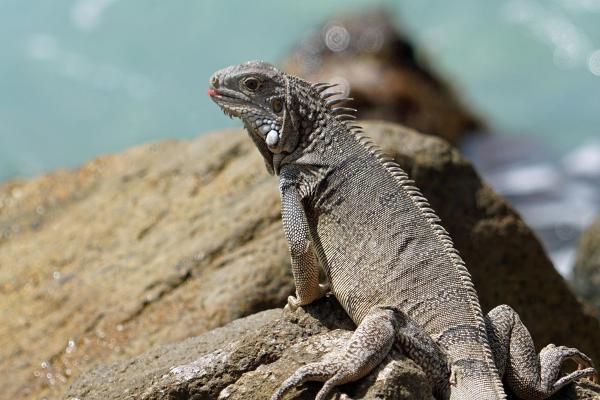
The course of various evolutionary processes has allowed animals to adapt to various environments. These adaptations are required due to the changes in such environments. Changes in temperature is one of the most impactful on an animal's chances of survival. As the ambient, ground and even water temperatures change in an animal's environment, they will need to maintain a certain body temperature to carry out their bodily functions. This is a process known as thermoregulation. It is thermoregulation which explains the difference between homeotherms and poikilotherms.
At AnimalWised, we look at the definition of homeothermic and poikilothermic animals. We explain the characteristics and differences between these two types of animals, as well as provide examples of both in nature.
Homeothermic animals - definition and characteristics
The term ‘homeo’ derives from Greek and means ‘same’ or ‘similar’. We can use this definition to help us understand homeothermic animals, otherwise known as homeotherms. This is because the definition of a homeotherm is:
An animal or organism that maintains a relatively constant body temperature.
The ability to maintain a relatively steady body temperature is due to internal physiological processes. Since these process are internal, it means they are endothermic (i.e. their heat comes from within). Such processes allow the organism to maintain their bodily functions, even when the external environment changes drastically.
Traditionally, homeothermic animals have been known as ‘warm-blooded animals’. While this can help us to remember the differences between homeotherms and poikilotherms, it is not an entirely accurate description. This is because it implies there are only two types of animal, i.e. warm-blooded and cold-blooded animals. In actuality, there are many different types of thermoregulation in animals.
Nature is rarely absolute. Its dynamics are relative to the various processes which are required for the survival of living organisms. This is true when applied to homeothermic animals. While many homeotherms have a relatively stable body temperature above the temperature of their environment, many can drop their body temperatures considerably at certain times.
Perhaps the most well-known example of such a drastic drop in body temperature is when animals hibernate. Hibernating animals live in habitats where ambient temperatures can drop to below freezing levels. In response to this change in temperature, these animals lower their metabolic rate and slow down various bodily processes. When their metabolic processes slow, their body temperature drops below what is considered normal for their species.
An example of an otherwise homeothermic animal dropping its body temperature is found in the Arctic ground squirrel (Urocitellus parryii). Since food and other resources are so scarce during winter, this species is obligated to hibernate in the wild. Their body temperature drops, meaning they are a homeothermic animal which can drop their body temperature thanks to a reduction in metabolic activity.
Only birds and mammals are currently considered true homeothermic animals. There is an exception in the reptile group of animals, specifically the Argentine black and white tegu (Salvator merianae). This homeothermic lizard has some endothermic behavior, but also relies on environmental temperature for survival.
Learn about variations in dormancy among animals with our article on what is brumation in animals?

Poikilothermic animals - definition and characteristics
The term ‘poikilo’ is also of Greek origin and means ‘varied’. In this case, the definition of a poikilotherm is:
An animal or organism that has a considerably variable temperature.
The reason why poikilotherms have a highly variable temperature is because they cannot self-regulate it. Accordingly, their body temperature varies according to the environmental temperature. As a contract to endothermic behavior, this means that poikilotherms are exothermic since their heat comes from external sources. It is for this reason they are known as ‘cold-blooded animals’, despite this being and imprecise description of their type of thermoregulation.
Poikilothermic animals are exposed to various temperatures in their environment. Since their body does not have the ability to thermoregulate, they depend on external sources of heat and cold to do so. It is a process also known as poikilothermia. This is commonly seen in reptiles which sunbathe on hot rocks to keep themselves warm. A key distinction to make is that poikilotherms do produce heat, but they are unable to retain it like homeotherms.
Despite the fact that a animals which use poikliothermia cannot normally live in a habitat with extreme temperatures, it has an important advantage over homeotherms. Unlike homeotherms, poikilothermic animals can survive without eating for much longer periods. This is because they do not depend on metabolizing what they ear to maintain body temperature. Homeotherms also do not tolerate internal temperature changes very well. Although there are exceptions, poikilotherms are generally much better at doing so.
There are very rare cases of poikilothermic mammals, but most are found in other types of animal orders such as reptiles and amphibians. Find out about other internal process of these animals with our article on how reptiles breathe.

Differences between homeothermic and poikilothermic animals
As explained above, the main difference between homeothermic and poikilothermic animals is found in the regulation of body temperature. While homeotherms maintain an internal body temperature even when the environmental temperature changes, poikilotherms are unable to regulate their body temperature themselves. In the case of the latter, they need to find various mechanisms from their environment to do so.
To see the difference between homeotherms and poikilotherms, we can look at specific examples of how these types of thermoregulation work:
- An arctic wolf (Canis lupus arctos) can be in areas with icy temperatures thanks to its metabolic mechanisms. They are also able to use their thick fur to keep their body temperature relatively stable.
- A lizard can have optimal activity in a temperature range between 30 and up to 38 ºC (86 to 100.4 ºF). If their body temperature drops below this range, it is common to see them sunbathing or lying on a hot rock to warm themselves, since they cannot self-regulate.
As they have a higher metabolic rate, homeothermic animals require a greater consumption of food to be able to transform it into the energy they need to survive. This means their periods without eating are more limited. This is unlike poikilotherms which can go longer periods without eating.
We have seen that some animals which are homeothermic will change their temperature dramatically due to processes such as hibernation. In these cases, we can say some animals are technically heterothermic[1]. Although they have endothermic ability, they use this ability to drop their temperatures during periods of dormancy thanks to a lower metabolic rate.
Examples of homeothermic and poikilothermic animals
Now we have seen their general characteristics and main differences between homeothermia and poikliothermia, it will be helpful to look at examples of homeothermic and poikilothermic animals in nature:
Examples of homeothermic animals
Starting with homeotherms, some of the most representative examples are:
- Southern mealy parrot (Amazona farinosa)
- House mouse (Mus musculus)
- American buffalo (Bison bison)
- Chimpanzee (Pan troglodytes)
- Emperor penguin (Aptenodytes forsteri)
- Arctic fox (Vulpes lagopus)
Examples of poikilothermic animals
With examples of poikilotherms, we find the following animals in nature:
- Marine iguana (Amblyrhynchus cristatus)
- Gila monster (Heloderma suspectum)
- American crocodile (Crocodylus acutus)
- Bullet ant (Paraponera clavata)
- Great green bush-cricket (Tettigonia viridissima)
- Moon jellyfish (Aurelia aurita)
Find out more detail about how we categorize animals with our articles on examples of regeneration in animals and examples of animals that can play dead.

If you want to read similar articles to Homeothermic and Poikilothermic Animals, we recommend you visit our Facts about the animal kingdom category.
1. Baust, J. G., & Brown, R. T. (1980). Heterothermy and cold acclimation in the arctic ground squirrel, Citellus undulatus. Comparative Biochemistry and Physiology Part A: Physiology, 67(3), 447-452.
https://www.sciencedirect.com/science/article/abs/pii/S0300962980800211
- Arenas, M. (2015). All you need is biology. Retrieved from: https://allyouneedisbiology.wordpress.com/2015/09/19/animales-sangre-caliente-fria/
- Hickman, C., Roberts, L., & Parson, A. (2000). Comprehensive principles of zoology. McGraw Hill Inter-American: Spain.